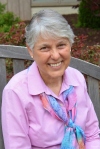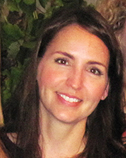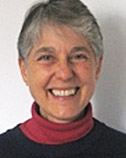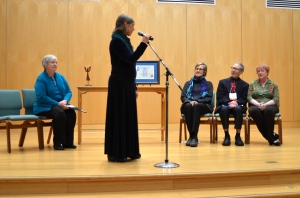Today’s post is by Bryan Berghoef
“The object of pilgrimage is not rest and recreation—to get away from it all. To set out on a pilgrimage is to throw down a challenge to everyday life. Nothing matters now but this adventure.”
~Huston Smith
The alarm went off, and my wife and I sleepily rolled out of bed, roused the children, brewed the coffee, and started the day. A few hastily-made lunches and bowls of cereal later, and the kids were ready to head out the door to school. A regular scene. A snapshot of hundreds of other similar days. OK, some days I hit snooze (or most days!).
We are all traveling somewhere, whether we regularly find ourselves at the airport, on a path through some untamed wilderness, or at the kitchen table. Life’s journey moves us from one place to another, and we are the unwitting (and sometimes unwilling) passengers.
For many of us, amid the routine of daily life, we might begin to imagine that a fabulous journey to a new locale is only a rare occurrence. Perhaps something that happens very infrequently in our lives, maybe only once or twice. Day after day—if we’re fortunate—we wake up in a familiar bed, wash up in a familiar bathroom, look in the same mirror, pour the same bowl of cornflakes.
Routine is a wonderful and comforting thing, like a special blanket or a favorite chair. Without it, we might find ourselves adrift, always trying to find our footing. Yet routine can sneak up on us. It can lull us to sleep about this very rare, precious thing that is our life. A little travel or change of scenery can sometimes snap us out of this sleepy reverie. Yet travel isn’t possible for all of us—whether for financial, physical, or health reasons. Phil Cousineau invites us, in his book, The Art of Pilgrimage, to extend our vision of pilgrimage to something beyond an actual journey to Jerusalem, Mecca, or Machu Picchu.
He invites us to think about unique times or stages in our lives that might hold a special difficulty. Perhaps extended time at the bedside of a loved one in hospice could be seen as a pilgrimage of sorts. Or walking with a child through a health crisis, or a learning challenge. Maybe a short-term job assignment, or an unwelcome task that comes our way could be reframed in this way. Perhaps even just a regular day on the calendar could be reimagined.
This is not to make light of break-out-the-map-and-the-hiking-boots pilgrimages. Those have their place as well. In fact, as I prepare to go on Shalem’s pilgrimage to Iona this coming June, part of my pilgrimage preparation is to cultivate the pilgrim’s mindset of “openness, attentiveness, and responsiveness.” One of the things that happens with travel, inevitably, is that something goes wrong—a flight is delayed and a connection is missed, or a hotel is booked that we were counting on, or we wander off the trailhead and find ourselves off the map. And so we are encouraged to “have a purchase on our surroundings by being centered in ourselves, not somewhere in the outer world.”
The invitation, then, in my daily life, is twofold: 1) Am I centered in myself, and indeed, in something greater than myself? And 2) Am I attentive to the small details that fall my way?
Am I intentional in making time to connect with the Spirit, amid schedule, meetings, and an overly full inbox? Do I see something mundane, such as making breakfast for my kids, as a sort of wonder? Do I notice their delight when I announce we’re having eggs and toast instead of (the usual) cereal? Do I allow that delight to fuel me toward an attentiveness, openness, and enthusiasm about the rest of my day? I tried it out this morning, just to see. I soaked in those smiles a bit longer. I was more patient with slow-dressing children. I paid more attention as I said, “Have a great day today.” And it really did filter into the rest of my day. I have to say, I like this whole idea of “throwing down a challenge to everyday life.”
Look out, Monday, my hiking boots are on, and I’m coming for you.
 Bryan Berghoef is a pastor and writer who helps curate Shalem’s social media content and provides technical support for Shalem’s online courses. He is the author of the book, Pub Theology: Beer, Conversation, and God, and lives with his family in Holland, Michigan. You can follow Bryan on Facebook and Twitter.
Bryan Berghoef is a pastor and writer who helps curate Shalem’s social media content and provides technical support for Shalem’s online courses. He is the author of the book, Pub Theology: Beer, Conversation, and God, and lives with his family in Holland, Michigan. You can follow Bryan on Facebook and Twitter.
Interested in hitting the path with a group of other pilgrims? Shalem has several upcoming pilgrimage opportunities: Pilgrimage to Assisi: April 17-25 to Assisi, Italy; Iona Pilgrimage: June 2-12 to Iona, Scotland; A Pilgrimage to the Pacific Northwest: Sept 24-Oct 1, 2016 to the Olympic Peninsula, Washington State (more info coming soon).



 Carole Crumley, Shalem’s Director of Going Deeper: Clergy Spiritual Life and Leadership Program, is an Episcopal priest with experience in three congregations as well as at the Washington National Cathedral. She is a widely respected leader of ecumenical retreats, groups, and conferences, and a seasoned pilgrimage guide to sacred sites throughout Europe and the Middle East.
Carole Crumley, Shalem’s Director of Going Deeper: Clergy Spiritual Life and Leadership Program, is an Episcopal priest with experience in three congregations as well as at the Washington National Cathedral. She is a widely respected leader of ecumenical retreats, groups, and conferences, and a seasoned pilgrimage guide to sacred sites throughout Europe and the Middle East. Patience Robbins is a graduate of Shalem’s
Patience Robbins is a graduate of Shalem’s 
 Savannah Kate Coffey is a graduate of Columbia Theological Seminary and Shalem’s
Savannah Kate Coffey is a graduate of Columbia Theological Seminary and Shalem’s  Patience Robbins has recently been directing Shalem’s Young Adult Life and Leadership Initiative, and is a graduate of Shalem’s
Patience Robbins has recently been directing Shalem’s Young Adult Life and Leadership Initiative, and is a graduate of Shalem’s  Carole Crumley, Shalem Institute’s Senior Program Director, is an Episcopal priest and a widely respected leader of ecumenical retreats, groups, and conferences. She designs and leads Shalem’s
Carole Crumley, Shalem Institute’s Senior Program Director, is an Episcopal priest and a widely respected leader of ecumenical retreats, groups, and conferences. She designs and leads Shalem’s 


